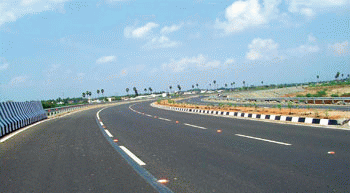The amount of Rs.800 cr budgeted for ports and inland waterways appears to be below the potential of these sectors.
The Union Budget 2016-17 lists infrastructure among one of the four priority areas. However, it refrains from making big policy announcements to restart the private investment cycle, and is largely limited to tax proposals and expenditure allocations. This is positive, in that it indicates continuity of the past policies. It supplements several measures already underway in various line ministries, such as projects under Sagarmala programme, financing of Smart Cities and Amrut, and Hybrid Annuity Model for National Highways.
While the Budget significantly increases public spend in key infrastructure sectors, the governmentRs.s inability to continue large scale infrastructure financing is evident. Several more measures are needed to draw further private investment and participation in roads, railways, airports, waterways, housing, etc.
Budget vs Requirements
The roads and highways sector is the prominent one with 24 per cent increase in Budget allocation. However, an additional Rs.30,000 crore in private investments is still needed over and above the allocation of Rs.55,000 crore and the proposed Rs.15,000 crore to be raised by NHAI through bonds, to meet the target of development of 10,000 km in the year.
The ground for this has been laid well, with about Rs 80,000 crore worth of projects under implementation, including Rs.25,000 crore worth of PPP projects awarded in 2015-16. The Rail Budget also increases the investment target to Rs.1.2 lakh crore, a part of which will be met through gross budgetary support. Given the declining operating ratio, and with freight and passenger traffic remaining nearly flat, the Railways will need to quickly devise private investment models to be able to achieve the target.
The amount of Rs.800 crore budgeted for ports and inland waterways appears below the potential of these sectors, though ports can largely raise private capital. Progress on corporatisation of major ports remains slow. Corporatisation of ports can significantly enhance self-financing ability. Inland waterways, however, will need significant public investments initially, until it reaches a more mature stage.
Airports need both capital and expertise to deliver to its potential. The limited success of Durgapur airport has highlighted that new airport development in private sector is difficult in an environment where long term capital is scarce. In this context, the proposal to finance regional airports jointly with state governments is a good one. This model can be made more effective by bringing private sector capabilities into operations. Initiatives to bring private sector capital and expertise into airports have slowed down.
Increased emphasis on rural infrastructure overshadowed urban financing which had found strong support in the last few years. However, affordable housing continues to be centre- stage, and several more concessions have been announced. These will need to be supplemented with ground level reforms on land and legal issues to attract large developers to the really low-cost end of the spectrum. Strong legal framework for better balanced tenancy laws could give a significant fillip to the rental housing model of development. Exemption of dividend distribution tax for REITs is a strong step towards channelling more funding into real estate projects, which will also benefit Smart City projects.
For industrial parks, developers, lower income tax rate for new manufacturing companies, along with changes in customs duty, could give a stronger push to Make in India. As the capital investment cycle is expected to restart with the continuously growing economy, it will result in demand returning for land in industrial parks. With good quality infrastructure, several such parks in the private and public sector are geared to emerge as competitive locations for manufacturing. While SEZ concessions are being phased out, a harmonised set of policies across different types of industrial areas is still needed.
Easing Funding
Banks need to be recapitalised to be able to start lending to new PPP projects. The budgeted Rs.25,000 crore is inadequate, and the shortage will potentially delay growth in private investment in the longer term. However, the tight funding keeps lenders focussed on carefully resolving stressed assets, instead of promoting moral hazard. There are important lessons to be learnt from the over-leveraging experience of PPP investors. Also, more details of the National Infrastructure Investment Fund were expected in this Budget. It will hopefully be clarified subsequently that how would the NIIF complement infrastructure financing system. Exemption from dividend distribution tax for REITs and InvITs will give a fillip to this channel of financing, including for Smart City projects.
Kelkar Committee proposals
It is a challenge for the line ministries and state governments to back high-risk new projects in absence of large scale private investment. In addition to low-risk models such as Hybrid Annuity, there may be more innovative ones involving selling / securitising existing assets and cash-flows. This was also recommended by the Kelkar Committee. However, there is some level of disappointment at insufficient push to implement the committeeRs.s other recommendations. The government may implement those as well to address the concerns of private investors, including constituting infrastructure PPP review committee, amending Prevention of Corruption Act, and setting up National Facilitation Committee.
Implications for stakeholders
Construction companies were already seeing an upswing in their order books, and the increased spending on roads, railways and irrigation will continue this trend. However, increased rural spending may have only marginal impact on large construction companies, if such contracts are more suited for local players. For infrastructure owners and operators, addressing stressed assets remains priority over pursuing new projects. Towards this, the budget proposes introducing guidelines for renegotiation of PPPs and the Resolution of Disputes Bill, as suggested by the Kelkar Committee. If these can be speedily implemented, the impact on the sector would be much more than the long list of announcements in earlier Budgets.
This article has been authored by Sandeep Upadhyay, MD&CEO, Centrum Infrastructure Advisory.



Leave a Reply
You must be logged in to post a comment.